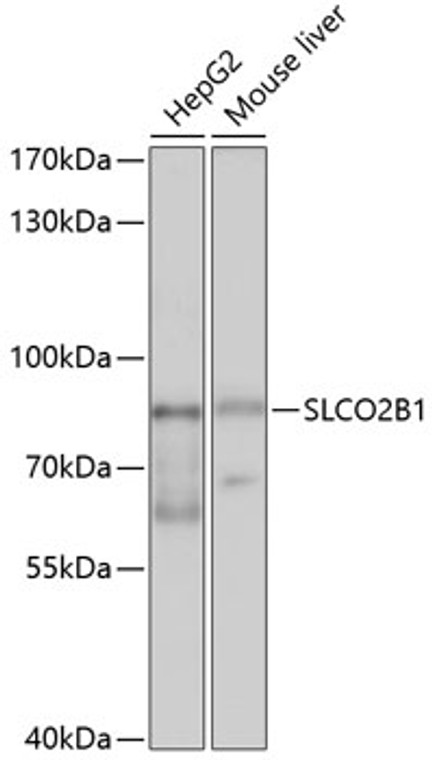| Host: |
Rabbit |
| Applications: |
WB |
| Reactivity: |
Human/Mouse |
| Note: |
STRICTLY FOR FURTHER SCIENTIFIC RESEARCH USE ONLY (RUO). MUST NOT TO BE USED IN DIAGNOSTIC OR THERAPEUTIC APPLICATIONS. |
| Short Description: |
Rabbit polyclonal antibody anti-SLCO2B1 (130-210) is suitable for use in Western Blot research applications. |
| Clonality: |
Polyclonal |
| Conjugation: |
Unconjugated |
| Isotype: |
IgG |
| Formulation: |
PBS with 0.02% Sodium Azide, 50% Glycerol, pH7.3. |
| Purification: |
Affinity purification |
| Dilution Range: |
WB 1:500-1:2000 |
| Storage Instruction: |
Store at-20°C for up to 1 year from the date of receipt, and avoid repeat freeze-thaw cycles. |
| Gene Symbol: |
SLCO2B1 |
| Gene ID: |
11309 |
| Uniprot ID: |
SO2B1_HUMAN |
| Immunogen Region: |
130-210 |
| Immunogen: |
Recombinant fusion protein containing a sequence corresponding to amino acids 130-210 of human SLCO2B1 (NP_009187.1). |
| Immunogen Sequence: |
LLMTLPHFISEPYRYDNTSP EDMPQDFKASLCLPTTSAPA SAPSNGNCSSYTETQHLSVV GIMFVAQTLLGVGGVPIQPF G |
| Tissue Specificity | Strongly expressed in the liver, at the sinusoidal membrane of the hepatocytes. Expressed in the kidney. Expressed in placental trophoblasts and syncytiotrophoblast. Expressed in the small intestine. Expressed in the blood-brain barrier, in endothelial cells of brain capillaries. Expressed in the retina, in the inner nuclear layer and the inner plexiform layer. Expressed in skelettal muscles. In testis, primarily localized to the basal membrane of Sertoli cells and weakly expressed within the tubules. Also expressed in pancreas, lung, heart, colon, ovary and spleen. Expressed in fetal brain, heart, kidney, liver, lung, skeletal muscle, spleen and pancreas. Isoform 1: Highest expression in brain. Predominant isoform compared to isoform 3 in small intestine duodenum, kidney, placenta, and skeletal muscle. Isoform 3: Predominant isoform compared to isoform 1 in liver. Also expressed in small intestine duodenum, kidney, brain, placenta, and skeletal muscle. |
| Function | Mediates the Na(+)-independent transport of steroid sulfate conjugates and other specific organic anions. Responsible for the transport of estrone 3-sulfate (E1S) through the basal membrane of syncytiotrophoblast, highlighting a potential role in the placental absorption of fetal-derived sulfated steroids including the steroid hormone precursor dehydroepiandrosterone sulfate (DHEA-S). Also facilitates the uptake of sulfated steroids at the basal/sinusoidal membrane of hepatocytes, therefore accounting for the major part of organic anions clearance of liver. Mediates the intestinal uptake of sulfated steroids. Mediates the uptake of the neurosteroids DHEA-S and pregnenolone sulfate (PregS) into the endothelial cells of the blood-brain barrier as the first step to enter the brain. Also plays a role in the reuptake of neuropeptides such as substance P/TAC1 and vasoactive intestinal peptide/VIP released from retinal neurons. May act as a heme transporter that promotes cellular iron availability via heme oxygenase/HMOX2 and independently of TFRC. Also transports heme by-product coproporphyrin III (CPIII), and may be involved in their hepatic disposition. Mediates the uptake of other substrates such as prostaglandins D2 (PGD2), E1 (PGE1) and E2 (PGE2), taurocholate, L-thyroxine, leukotriene C4 and thromboxane B2. May contribute to regulate the transport of organic compounds in testis across the blood-testis-barrier (Probable). Shows a pH-sensitive substrate specificity which may be ascribed to the protonation state of the binding site and leads to a stimulation of substrate transport in an acidic microenvironment. The exact transport mechanism has not been yet deciphered but most likely involves an anion exchange, coupling the cellular uptake of organic substrate with the efflux of an anionic compound. Hydrogencarbonate/HCO3(-) acts as a probable counteranion that exchanges for organic anions. Cytoplasmic glutamate may also act as counteranion in the placenta. An inwardly directed proton gradient has also been proposed as the driving force of E1S uptake with a (H(+):E1S) stoichiometry of (1:1). Isoform 3: Has estrone 3-sulfate (E1S) transport activity comparable with the full-length isoform 1. |
| Protein Name | Solute Carrier Organic Anion Transporter Family Member 2b1Organic Anion Transporter BOatp-BOrganic Anion Transporter Polypeptide-Related Protein 2Oatp-Rp2Oatprp2Organic Anion Transporting Polypeptide 2b1Oatp2b1Solute Carrier Family 21 Member 9 |
| Database Links | Reactome: R-HSA-189483 O94956-3Reactome: R-HSA-879518Reactome: R-HSA-9749641 O94956-1Reactome: R-HSA-9754706 O94956-3 |
| Cellular Localisation | Cell MembraneMulti-Pass Membrane ProteinBasal Cell MembraneBasolateral Cell MembraneApical Cell MembraneExpressed At The Basal Membrane Of HepatocytesSyncytiotrophoblast And Sertoli CellsLocalized To The Basolateral Membrane Of EnterocytesAlso Found At The Apical Membrane Of Enterocytes |
| Alternative Antibody Names | Anti-Solute Carrier Organic Anion Transporter Family Member 2b1 antibodyAnti-Organic Anion Transporter B antibodyAnti-Oatp-B antibodyAnti-Organic Anion Transporter Polypeptide-Related Protein 2 antibodyAnti-Oatp-Rp2 antibodyAnti-Oatprp2 antibodyAnti-Organic Anion Transporting Polypeptide 2b1 antibodyAnti-Oatp2b1 antibodyAnti-Solute Carrier Family 21 Member 9 antibodyAnti-SLCO2B1 antibodyAnti-KIAA0880 antibodyAnti-OATP2B1 antibodyAnti-OATPB antibodyAnti-SLC21A9 antibody |
Information sourced from Uniprot.org
12 months for antibodies. 6 months for ELISA Kits. Please see website T&Cs for further guidance






